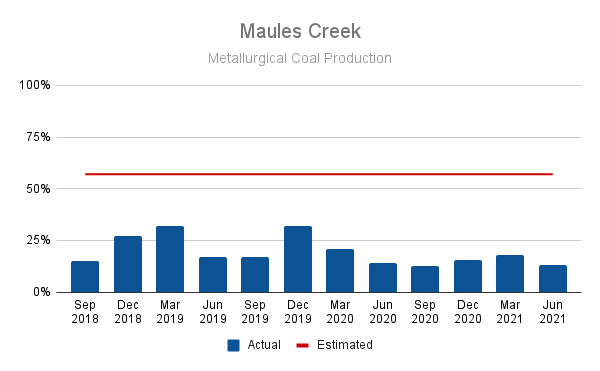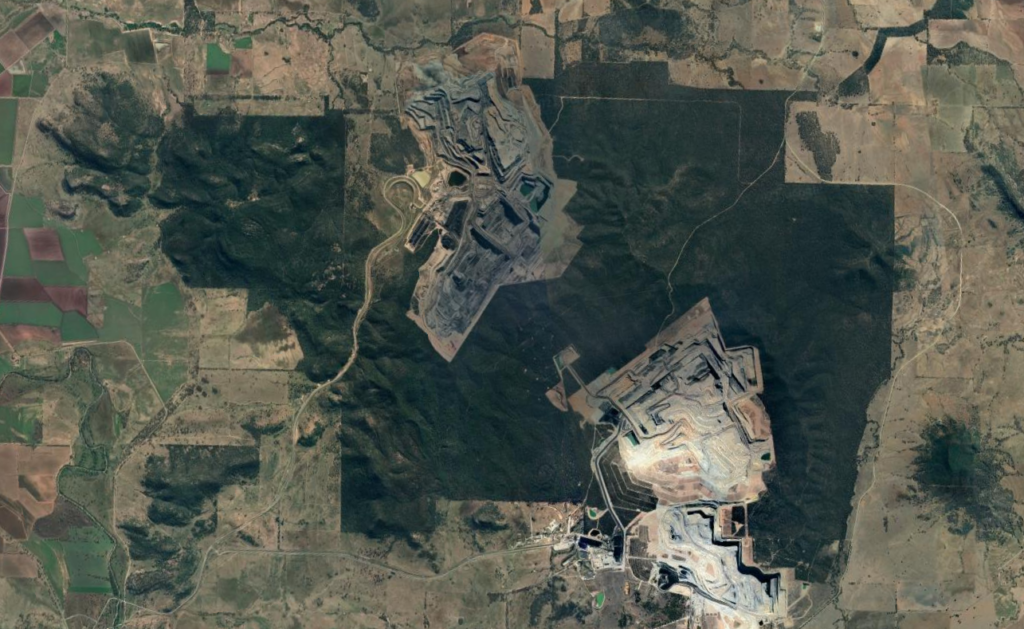11 May 2022
Whitehaven Coal is Australia’s biggest publicly-listed pure play coal mining company. It operates four coal mines in New South Wales, and is pursuing a further three new or expanded mines that could double the company’s coal production by 2030. The company’s coal expansion plans are completely out of line with what is required to limit global warming to 1.5ºC or achieve net zero emissions by 2050.
In its 2021 annual report, Whitehaven claims its proposed Vickery and Winchester South coal mines would help to “rebalance” its mining portfolio towards metallurgical coal (used for steel-making) and away from thermal coal (used for electricity generation) [1].
However, new research from Energy & Resource Insights shows that Whitehaven has greatly overestimated metallurgical coal production at its existing Maules Creek and Tarrawonga mines, casting doubt on the company’s coal production claims for its Vickery and Winchester South mines.
Investors and the public should be sceptical of Whitehaven’s claims to be expanding metallurgical coal production.
Assessment of coal production at existing mines
Of Whitehaven’s four operational coal mines, only two produce substantial volumes of metallurgical coal (Maules Creek and Tarrawonga). The Maules Creek coal mine is the company’s largest mine, producing almost 13 million tonnes per year [2].
Environmental assessments produced for the Maules Creek coal mine in 2012 stated the proposed coal production for the project was anticipated to consist of 57% metallurgical coal and 43% thermal coal [3]. This is consistent with Whitehaven’s investor communications at the time, which claimed around 48% metallurgical coal production and a potential for 84% [4]. More recently, a target of 50% metallurgical coal production was announced in Whitehaven’s FY18 results presentation [5]. Energy & Resource Insights’ assessment of actual metallurgical coal production at Maules Creek reveals a stark difference with these estimates. Metallurgical coal production since September 2018 has averaged 20%, less than half the 57% claimed in the mine’s environmental assessment [6].
Whitehaven’s production reports do not provide enough detail to analyse coal production at its Tarrawonga mine in the same way. However, the environmental assessment for that mine claimed around 80% of production would be metallurgical coal [7]. The most recent production data, from 2017, showed the mine was only producing 50% metallurgical coal [8].
Take action
Tell Whitehaven’s financiers to walk away!

Assessment of production at proposed new mines
Whitehaven has two proposed mines that on-paper claim to be majority metallurgical coal mines. Approval documents and promotional material for the Vickery mine have claimed metallurgical coal production of around 60-70% [9]. Similarly, the Winchester South draft environmental impact statement claims “metallurgical coal would account for up to 60% of coal products produced” (emphasis added) [10].
These claimed metallurgical coal volumes are remarkably similar to those claimed for the Maules Creek coal mine. If the production history at Maules Creek and Tarrawonga is any guide, the Vickery and Winchester South mines are very unlikely to produce the claimed volumes of metallurgical coal and may in fact be majority thermal coal mines.
So what’s the big deal?
Despite claims to be increasing metallurgical coal production, Whitehaven remains a predominantly thermal coal mining company. In the last financial year, over 80% of revenues were from thermal coal, consistent with the company’s operations over the last decade. While Whitehaven may claim its Vickery and Winchester South mines are majority metallurgical coal assets, there is a significant risk these estimates greatly understate the likely actual thermal coal production.
Regardless, Whitehaven’s proposed new and expanded coal mines put the company at odds with conclusions of climate scientists and the International Energy Agency (IEA). As the IEA made clear in its Net Zero by 2050 report, achieving this target means “no new coal mines or mine extensions are required” [11]. This is supported by the latest Intergovernmental Panel on Climate Change (IPCC) report, which found coal use must reduce by around 75% by 2030 on 2019 levels to limit global warming to 1.5ºC with no or low overshoot [12].
Instead of planning huge increases in coal production, Whitehaven should be rapidly winding down its existing coal assets in a manner consistent with limiting global warming to 1.5ºC.

Maps data: Google, © 2 July 2020 Maxar Technologies, CNES / Airbus
[1] Whitehaven Coal, Annual Report (2021) p 2. [2] Ibid p 5. [3] Hansen Bailey, Maules Creek Coal Project Environmental Assessment – Executive Summary (2010) p 19. [4] Whitehaven Coal, Managing Director’s Presentation to UBS Conference (November 2012) p 7. [5] Whitehaven Coal, FY2018 Results Presentation (14 August 2018) p 19. [6] Energy & Resources Insights, Whitehaven Coal: planned metallurgical coal production vs reality (April 2022) pp 3-4. [7] Tarrawonga Coal Pty Ltd, Tarrawonga Coal Project Environmental Assessment, Section 2 – Project Description (2012) p 2-53. [8] Whitehaven Coal, Australia’s Leading High-Quality Coal Company – Corporate Profile (March 2017) p 7. [9] Whitehaven Coal, Vickery Coal Project – Air Quality and Greenhouse Gas Assessment (1 November 2012) p D-8; Whitehaven Coal, Australia’s Leading High-Quality Coal Company – Corporate Profile (March 2017) p 7. [10] Whitehaven Coal, Winchester South Project, – Environmental Impact Statement – Section 2 Project Description (9 November 2021) p 2-55. [11] International Energy Agency, Net Zero by 2050 (May 2021). [12] Carbon Brief, In-depth Q&A: The IPCC’s sixth assessment on how to tackle climate change (5 April 2022).
